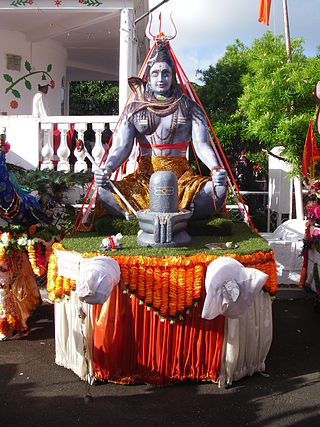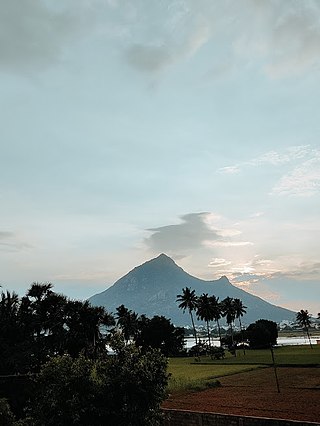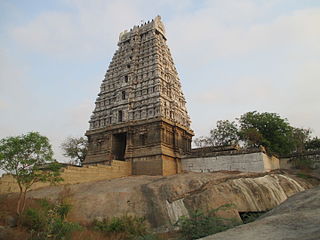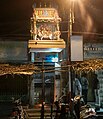
Ramana Maharshi was an Indian Hindu sage and jivanmukta. He was born Venkataraman Iyer, but is mostly known by the name Bhagavan Sri Ramana Maharshi.

Maha Shivaratri is a Hindu festival celebrated annually in honour of the deity Shiva, between February and March. According to the Hindu calendar, the festival is observed on the fourteenth day of the dark (waning) half of the lunar month of Phalguna or Magha. The festival commemorates the wedding of Shiva and Parvati, and the occasion that Shiva performs his divine dance, called the Tandava.

Kartika Deepam is a festival of lights that is observed mainly by Hindu Tamils, and also by adherents in the regions of Kerala, Andhra Pradesh, Telangana, Karnataka, and Sri Lanka. Celebrated in Tamilakam and Sri Lanka since the ancient period, the festival is held on the full moon day of the Kartika (கார்த்திகை) month, called the Kartika Pournami, falling on the Gregorian months of November or December. It is marked on the day the full moon is in conjunction with the constellation of Kartika. It corresponds to the occasion of the Kartika Purnima, though it falls on a different day due to the correction of equinoxes in the Tamil calendar.

Sri Seshadri Swamigal, also known as the "Saint with a Golden Hand", was a male Indian saint born in Kanchipuram, Tamil Nadu, who predominantly lived in Tiruvannaamalai where he attained Samadhi.

Parikrama or Pradakshina is clockwise circumambulation of sacred entities, and the path along which this is performed, as practiced in the Indic religions – Hinduism, Buddhism, Sikhism and Jainism. In Buddhism, it refers only to the path along which this is performed. Typically, in Indic-religions the parikrama is done after completion of traditional worship and after paying homage to the deity. Parikrama must be done with dhyāna.

Self-enquiry, also spelled self-inquiry, is the constant attention to the inner awareness of "I" or "I am" recommended by Ramana Maharshi as the most efficient and direct way of discovering the unreality of the "I"-thought.

Arunachalesvara Temple is a Hindu temple dedicated to the deity Shiva, located at the base of Arunachala hill in the town of Tiruvannamalai in Tamil Nadu, India. It is significant to the Hindu sect of Shaivism as one of the temples associated with the five elements, the Pancha Bhuta Sthalams, and specifically the element of fire, or Agni.

Arunachala is a hill in Tiruvannamalai, Tamil Nadu, and one of the five main Shaiva holy places in South India. The Arunachalesvara Temple to Shiva is located at the base of the hill. The hill is also known by the names Annamalai, Arunagiri, Arunachalam, Arunai, Sonagiri, and Sonachalam.

Nome is a spiritual teacher at Society of Abidance in Truth, known by the acronym SAT, which established and maintains a temple for nondual Self-knowledge in California. He expounds the teachings of Sri Ramana Maharshi and Advaita Vedanta. He, along with Dr. H. Ramamoorthy, translated into English the essential and classic work of Advaita Vedanta, "Ribhu Gita", which was highly recommended by Sri Ramana Maharshi. The English translation has been published by Society of Abidance in Truth and has since then been re-published by Sri Ramanasramam and translated into Hindi, Italian, Korean and German.
Sri Ramana Ashram, also known as Sri Ramanasramam, is the ashram which was home to modern sage and Advaita Vedanta master Ramana Maharshi from 1922 until his death in 1950. It is situated at the foot of the Arunachala hill, to the west of Tiruvannamalai, Tamil Nadu, where thousands of seekers flocked to be in his presence. His samadhi shrine continues to attract devotees from all over the world.

The Thayumanavar Temple is a temple situated in the Rockfort complex in the city of Tiruchirappalli, India. Shiva is worshipped as Thayumanavar, and is represented by the lingam and his consort Parvati is depicted as Mattuvar Kuzhalammai. The presiding deity is revered in the 7th century Tamil Saiva canonical work, the Tevaram, written by Tamil saint poets known as the nayanars and classified as Paadal Petra Sthalam.
Arthur Osborne was an English writer on spirituality and mysticism, and an influential disciple and biographer of Ramana Maharshi.

Robert Adams was an American Advaita teacher. In later life Adams held satsang with a small group of devotees in California, US. He mainly advocated the path of jñāna yoga with an emphasis on the practice of self-enquiry. Adams' teachings were not well known in his lifetime, but have since been widely circulated amongst those investigating the philosophy of Advaita and the Western devotees of Bhagavan Sri Ramana Maharshi. A book of his teachings, Silence of the Heart: Dialogues with Robert Adams, was published in 1999.
The Prabhu Linga Leelai Venpaas in Tamil written by Siva Prakasar also called as 'Siva anuputhi selvar, 'Karpanai Kalangiyam', 'Thurai mangalam Sivaprakasar'. He compiled more than thirty original works and few more translation works from Kannada and Sanskrit.

David Godman has written on the life, teachings and disciples of Ramana Maharshi, an Indian sage who lived and taught for more than fifty years at Arunachala, a sacred mountain in Tamil Nadu, India. In the last 30 years Godman has written or edited 16 books on topics related to Sri Ramana, his teachings and his followers.

Atulya Nadheswarar Temple is a Hindu temple dedicated to the deity Shiva, located in Arakandanallur in Thirukoilur taluk, a town panchayat in Viluppuram district in the South Indian state of Tamil Nadu. Shiva is worshipped as Atulya Nadheswarar, and is represented by the lingam. His consort Parvati is depicted as Azhagiya Ponnazhagi. The presiding deity is revered in the 7th century Tamil Saiva canonical work, the Tevaram, written by Tamil saint poets known as the Nayanars and classified as Paadal Petra Sthalam.

Tiruvannamalai is a city, a spiritual, cultural, economic hub and also the administrative headquarters of Tiruvannamalai District in the Indian state of Tamil Nadu. The city is home to the renowned Annamalaiyar temple, Annamalai hill, Girivalam and the Karthigai Deepam festival and a prominent pilgrimage destination.
Adi Annamalaiyar Temple is a Siva temple in Adi Annamalai in Tiruvannamalai district in Tamil Nadu (India). This temple is in fact older than the “big” temple in Tiruvannamalai. Like the lingam in the big temple, the lingam in the Adi Annamalai temple is also a swayambhu lingam.

Manavasi Ramaswami Iyer was a devotee of Ramana Maharshi. He composed the well-known song Saranagati in his devotion to Ramana Maharshi, which is still sung by devotees of Ramana Maharshi today.
























